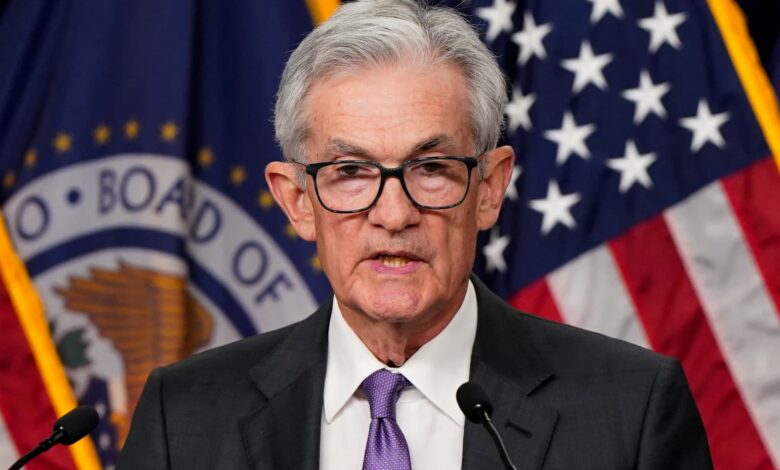Fed slashes interest rates by a half point, an aggressive start to its first easing campaign in four years

WASHINGTON – The Federal Reserve on Wednesday enacted its first interest rate cut since the early days of the Covid pandemic, slicing half a percentage point off benchmark rates in an effort to head off a slowdown in the labor market.
With both the jobs picture and inflation softening, the central bank’s Federal Open Market Committee chose to lower its key overnight borrowing rate by a half percentage point, or 50 basis points, affirming market expectations that had recently shifted from an outlook for a cut half that size.
Outside of the emergency rate reductions during Covid, the last time the FOMC cut by half a point was in 2008 during the global financial crisis.
The decision lowers the federal funds rate to a range between 4.75%-5%. While the rate sets short-term borrowing costs for banks, it spills over into multiple consumer products such as mortgages, auto loans and credit cards.
In addition to this reduction, the committee indicated through its “dot plot” the equivalent of 50 more basis points of cuts by the end of the year, close to market pricing. The matrix of individual officials’ expectations pointed to another full percentage point in cuts by the end of 2025 and a half point in 2026. In all, the dot plot shows the benchmark rate coming down about 2 percentage points beyond Wednesday’s move.
“The Committee has gained greater confidence that inflation is moving sustainably toward 2 percent, and judges that the risks to achieving its employment and inflation goals are roughly in balance,” the post-meeting statement said.
The decision to ease came “in light of progress on inflation and the balance of risks.” Notably, the FOMC vote was 11-1, with Governor Michelle Bowman preferring a quarter-point move. Bowman’s dissent was the first by a Fed governor since 2005, though a number of regional presidents have cast “no” votes during the period.
“We’re trying to achieve a situation where we restore price stability without the kind of painful increase in unemployment that has come sometimes with this inflation. That’s what we’re trying to do, and I think you could take today’s action as a sign of our strong commitment to achieve that goal,” Chair Jerome Powell said at a news conference following the decision.
Trading was volatile after the decision with the Dow Jones Industrial Average jumping as much as 375 points after it was released, before easing somewhat as investors digested the news and considered what it suggests about the state of the economy.
Stocks ended slightly lower on the day while Treasury yields bounced higher.
“This is not the beginning of a series of 50 basis point cuts. The market was thinking to itself, if you go 50, another 50 has a high likelihood. But I think [Powell] really dashed that idea to some extent,” said Tom Porcelli, chief U.S. economist at PGIM Fixed Income. “It’s not that he thinks that’s not going to happen, it’s that he’s not he’s not pre-committing to that to happen. That is the right call.”
The committee noted that “job gains have slowed and the unemployment rate has moved up but remains low.” FOMC officials raised their expected unemployment rate this year to 4.4%, from the 4% projection at the last update in June, and lowered the inflation outlook to 2.3% from 2.6% previous. On core inflation, the committee took down its projection to 2.6%, a 0.2 percentage point reduction from June.
The committee expects the long-run neutral rate to be around 2.9%, a level that has drifted higher as the Fed has struggled to get inflation down to 2%.
The decision comes despite most economic indicators looking fairly solid.
Gross domestic product has been rising steadily, and the Atlanta Fed is tracking 3% growth in the third quarter based on continuing strength in consumer spending. Moreover, the Fed chose to cut even though most gauges indicate inflation well ahead of the central bank’s 2% target. The Fed’s preferred measure shows inflation running around 2.5%, well below its peak but still higher than policymakers would like.
However, Powell and other policymakers in recent days have expressed concern about the labor market. While layoffs have shown little sign of rebounding, hiring has slowed significantly. In fact, the last time the monthly hiring rate was this low – 3.5% as a share of the labor force – the unemployment rate was above 6%.
At his news conference following the July meeting, Powell remarked that a 50 basis point cut was “not something we’re thinking about right now.”
For the moment, at least, the move helps settle a contentious debate over how forceful the Fed should have been with the initial move.
However, it sets the stage for future questions over how far the central bank should go before it stops cutting. There was a wide dispersion among members for where they see rates heading in future years.
Investors’ conviction on the move vacillated in the days leading up to the meeting. Over the past week, the odds had shifted to a half-point cut, with the probability for 50 basis points at 63% just before the decision coming down, according to the CME Group’s FedWatch gauge.
The Fed last reduced rates on March 16, 2020, part of an emergency response to an economic shutdown brought about by the spread of Covid-19. It began hiking in March 2022 as inflation was climbing to its highest level in more than 40 years, and last raised rates in July 2023. During the tightening campaign, the Fed raised rates 75 basis points four consecutive times.
The current jobless level is 4.2%, drifting higher over the past year though still at a level that would be considered full employment.
“This was an atypical big cut,” Porceli said. “We’re not knocking on recessions’ door. This easing and this bit cut is about recalibrating policy for the fact that inflation has slowed so much.”
With the Fed at the center of the global financial universe, Wednesday’s decision likely will reverberate among other central banks, several of whom already have started cutting. The factors that drove global inflation higher were related mainly to the pandemic – crippled international supply chains, outsized demand for goods over services, and an unprecedented influx of monetary and fiscal stimulus.
The Bank of England, European Central Bank and Canada’s central bank all have cut rates recently, though others awaited the Fed’s cue.
While the Fed approved the rate cut, it left in place a program in which it is slowly reducing the size of its bond holdings. The process, nicknamed “quantitative tightening,” has brought the Fed’s balance sheet down to $7.2 trillion, a reduction of about $1.7 trillion from its peak. The Fed is allowing up to $50 billion a month in maturing Treasurys and mortgage-backed securities to roll off each month, down from the initial $95 billion when QT started.




